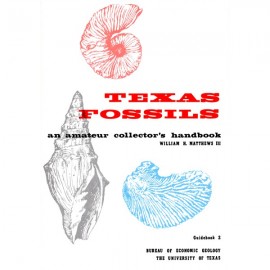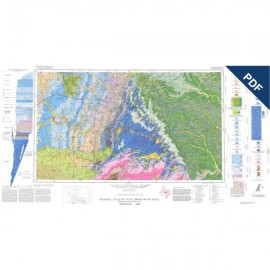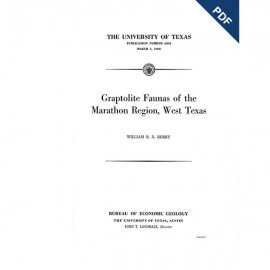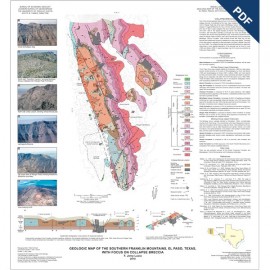Reports of Investigations
-
Books & Reports
- Reports of Investigations
- Guidebooks
- Udden Series
- Geological Circulars
- Down To Earth
- Atlases of Major Oil and Gas Reservoirs
- Texas Memorial Museum Publications
- Environmental Geologic Atlas of the Texas Coastal Zone
- Mineral Resource Circulars
- Other Reports
- Seminars and Workshops
- Handbooks
- Submerged Lands of Texas
- Symposia
- Annual Reports
- Open File Reports
-
Maps & Cross Sections
- Thematic Maps
- Miscellaneous Maps, Charts & Sections
- Geologic Atlas of Texas
- STATEMAP Project Maps
- Geologic Quadrangle Maps
- Cross Sections
- Highway Geology Map
- Energy and Mineral Resource Maps
- Shoreline Change and Other Posters
- Wilcox Group, East Texas, Geological / Hydrological Folios
- Bouguer Gravity Atlas of Texas
- River Basin Regional Studies
- Featured Maps
- Posters
- Teachers & the Public
-
Geological Society Publications
- Gulf Coast Association of Geological Societies
- Alabama Geological Society
- Austin Geological Society
- Corpus Christi Geological Society
- Houston Geological Society
- Lafayette Geological Society
- Mississippi Geological Society
- New Orleans Geological Society
- South Texas Geological Society
- GCS SEPM Publications
- Historic BEG & UT Series
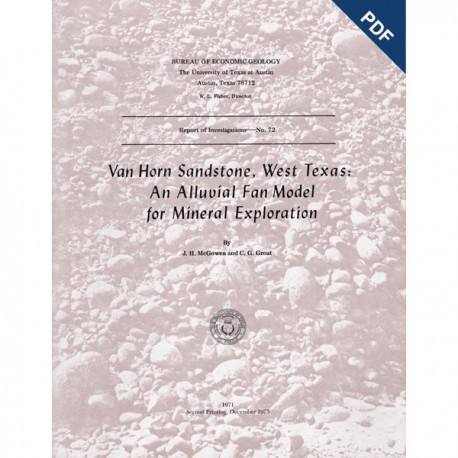
Van Horn Sandstone, West Texas: An Alluvial Fan Model for Mineral Exploration. Digital Download
RI0072D
A free, digital version of this publication can be found on: Texas ScholarWorks
To purchase a print version (if available): RI0072
RI0072D. Van Horn Sandstone, West Texas: An Alluvial Fan Model for Mineral Exploration, by J. H. McGowen and C. G. Groat. 57 p., 36 figs., 1971. doi.org/10.23867/RI0072D. Downloadable PDF.
To purchase this publication in book format, please order RI0072.
Excerpted from the Introduction
The Van Horn Sandstone in southwestern Culberson and southeastern Hudspeth counties, Texas, was studied in cooperation with the U.S. Geological Survey in order (1) to determine the gold-bearing potential of this terrigenous rock body, (2) to ascertain the geological conditions which influenced deposition of the Van Horn, (3) to correlate heavy metal occurrence or concentration with particular facies of the Van Horn, and (4) to derive a process-defined depositional model with which areas of heavy metal occurrence could be predicted and to which similar terrigenous rock bodies may be compared.
Composition of the Van Horn conglomerates was determined from field pebble counts. Thin sections of sandstones and matrix of conglomerates from the various facies were examined to determine any vertical or lateral variations in composition. In addition to studies of conglomerate and sandstone composition, clay-sized (< 2 m) materials for some of the muddy sandstones were analyzed by X-ray diffraction. Samples from each textural and structural type within each facies were analyzed for gold by atomic absorption method. Heavy mineral separates were made from sandstones and matrix of conglomerates of each of the facies; separates were studied by standard petrographic methods.
Keywords: alluvial fans, Culberson County, Hudspeth County, minerals, sandstone, Texas, Van Horn Sandstone, West Texas
Citation
McGowen, J. H., and Groat, C. G., 1971, Van Horn Sandstone, West Texas: An Alluvial Fan Model for Mineral Exploration: The University of Texas at Austin, Bureau of Economic Geology, Report of Investigations No. 72, 57 p. doi.org/10.23867/RI0072D.

